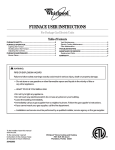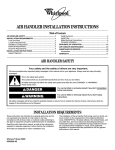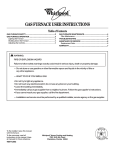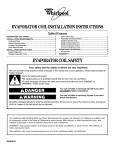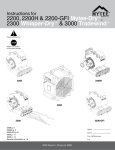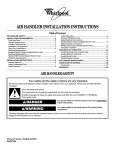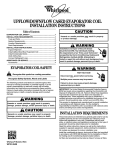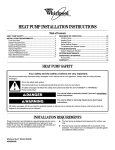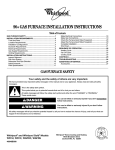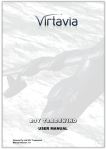Download Whirlpool furnace Specifications
Transcript
VARIABLE SPEED ELECTRIC FURNACE INSTALLATION INSTRUCTIONS Table of Contents VARIABLE SPEED ELECTRIC FURNACE SAFETY.....................1 INSTALLATION REQUIREMENTS ................................................2 Tools and Parts ............................................................................2 Location Requirements................................................................2 Installation Configurations ...........................................................3 Electrical Requirements ...............................................................4 Duct Work Requirements.............................................................4 INSTALLATION INSTRUCTIONS ..................................................4 Inspect Shipment .........................................................................4 Install Duct Work ..........................................................................5 Filter Specifications ......................................................................5 Make Electrical Connections .......................................................5 Complete Installation..................................................................10 SEQUENCE OF OPERATION ......................................................12 ELECTRIC FURNACE MAINTENANCE ......................................13 ASSISTANCE OR SERVICE .........................................................13 Accessories ................................................................................13 WARRANTY ..................................................................................14 VARIABLE SPEED ELECTRIC FURNACE SAFETY Your safety and the safety of others are very important. We have provided many important safety messages in this manual and on your appliance. Always read and obey all safety messages. This is the safety alert symbol. This symbol alerts you to potential hazards that can kill or hurt you and others. All safety messages will follow the safety alert symbol and either the word “DANGER” or “WARNING.” These words mean: You can be killed or seriously injured if you don't immediately follow instructions. You can be killed or seriously injured if you don't follow instructions. All safety messages will tell you what the potential hazard is, tell you how to reduce the chance of injury, and tell you what can happen if the instructions are not followed. 065682600 INSTALLATION REQUIREMENTS These instructions are intended to be a general guide and do not supersede any local or national codes. Installation must conform with the local building codes and with the latest editions of the National Electric Code. Read the entire instruction manual before starting the installation. All models are designed for indoor installations only. The unit is shipped from the factory completely assembled to be configured for upflow, counterflow, right to left or left to right air flow depending on the installation. Do not remove the cabinet knockouts until it has been determined which knockouts will need to be removed for the installation. The electric furnace may be used with an optional modular evaporator coil (WME) in upflow, counterflow, or horizontal applications. See “Airflow Configuration Options” for acceptable system configurations. The mounting plates and the necessary hardware to connect the electric furnace and modular evaporator coil cabinets together are included with this product. An optional electric heater may be installed in this cabinet. Select the final installation position which best suits the site conditions. Select any accessories that are to be included in the installation. Consider required clearances for the accessories to be used and the access space, filters, duct work, wiring, and service accessibility. For the electric heater accessory, refer to the electric heater rating plate for specific information regarding electrical supply. Tools and Parts Assemble the required tools and parts before starting installation. Read and follow the instructions provided with any tools listed here. Tools Needed: ■ ¹⁄₄ in. Nut driver ■ Adjustable wrench ■ Level ■ Tape measure ■ Screwdriver Parts Needed: Check local codes and HVAC supplier. Check existing electrical supply, and read “Electrical Requirements,” “Location Requirements,” and “Install Duct Work.” ■ UL listed wire nuts Location Requirements Explosion Hazard Keep flammable materials and vapors, such as gasoline, away from electric furnace. Place electric furnace so that heating elements are at least 18 inches (46 cm) above the floor for a garage installation. Failure to follow these instructions can result in death, explosion, or fire. 2 Installation Configuration Options Installation Configurations For ease in installation, it is best to make any necessary coil configuration changes before setting the electric furnace in place. See “Installation Configuration Options.” NOTE: Typical installations with optional WME modular evaporator coil are shown. Counterflow Vertical Installations Upflow/Counterflow The electric furnace must be supported on the bottom only and set on solid floor or field supplied supporting frame. Securely attach the electric furnace to the floor or supporting frame. Horizontal Installations Horizontal installations can be left-hand or right-hand air supply. The cabinet must be supported by the building structure to ensure cabinet integrity. Ensure that there is adequate room to remove the blower access panel if installing in the horizontal position. Suspended Cabinet Installation NOTE: Electric furnaces cannot be installed in such a way that the blower access panel is facing up or down. ■ The suspending means must be field fabricated, and should consist of two “cradles” made by attaching two rods to a length of angle iron or suitable gauge steel. ■ Locate the cradles so that they are as close as possible to the ends of the electric furnace (this will provide access for removal of major components such as the blower assembly). ■ Provide enough clearance between the suspension rods and the electric furnace to allow removal of the blower access panel. Upflow Left to Right Airflow Right to Left Airflow Horizontal 3 Electrical Requirements WARNING Duct Work Requirements ■ Install the conditioned air plenum, ducts and air filters (not provided) in accordance with NFPA 90B Standard for the Installation of Warm Air Heating and Air-Conditioning Systems (latest edition). ■ The electric furnace is provided with flanges for the connection of the plenum and ducts. ■ Air filters must be listed as Class 2 furnace air filters. ■ Supply and return duct work must be adequately sized to meet the system’s air requirements and static pressure capabilities. Duct work should be insulated with a minimum of 1 in. thick insulation with a vapor barrier in conditioned areas or 2 in. minimum in unconditioned areas. ■ Supply plenum should be the same size as the flanged opening provided around the blower outlet and should extend ideally at least 3 ft from the electric furnace before turning or branching off plenum into duct runs.The plenum forms an extension of the blower housing and minimizes air expansion losses from the blower. Electrical Shock Hazard Electrically ground furnace. Connect ground wire to green pigtail lead. Failure to do so can result in death or electrical shock. NOTE: Use copper conductors only. ■ All field wiring must be done in accordance with National Electrical Code, applicable requirements of UL and local codes. ■ Electrical wiring, disconnect means and overcurrent protection are to be supplied by the installer. Refer to the electric furnace rating plate for maximum overcurrent protection, minimum circuit ampacity, as well as operating voltage. ■ The power supply must be sized and protected according to the specifications supplied on the product. ■ This electric furnace is factory configured for 240 Volt, single phase, 60 cycles. For 208 Volt applications, see “208 Volt Conversion” in the “Make Electrical Connections” section. ■ For optional electric heater applications, see “Accessories.” Refer to the instructions provided with the accessory for proper installation. INSTALLATION INSTRUCTIONS Inspect Shipment WARNING Excessive Weight Hazard Use two or more people to move and install furnace. Failure to do so can result in back or other injury. The electric furnace is completely factory assembled, and all components are performance tested. Each unit consists of a blower assembly and controls in an insulated, galvanized factory finished enclosure. Knockouts are provided for electrical wiring entrance. 1. Check the unit rating plate to confirm specifications are as ordered. 2. Upon receipt of equipment, carefully inspect it for possible shipping damage. Take special care to examine the unit inside the carton if the carton is damaged. If damage is found, it should be noted on the carrier’s freight bill. Damage claims should be filed with the carrier immediately. Claims of shortages should be filed with the seller within 5 days. NOTE: If any damages are discovered and reported to the carrier, do not install the unit as your claim may be denied. 4 Minimum Filter Requirements Chart Install Duct Work Nominal Tons Air Conditioning & Nominal Airflow IMPORTANT: ■ Install duct work in accordance with NFPA 90B and any local codes. ■ ■ Connect supply air duct to the flange on top of the electric furnace. If an isolation connector is used, it must be nonflammable. If the free area is not known, assume a 25% free area for wood or a 75% free area for metal louvers or grilles. ■ If the return air plenum is used, the return air grille should be immediately in front of the opening in the plenum to allow for the free flow of return air. ■ When not installed in front of the opening, there must be adequate clearance around the electric furnace to allow for the free flow of return air. Filter Specifications Filters are not supplied with these air handlers. It is the installer's responsibility to install properly sized filters in accordance with the “Minimum Filter Requirements Chart.” ■ The filter size is determined by the “Nominal Tons Air Conditioning & Nominal Airflow” (see chart). ■ Areas and dimensions shown for cleanable filters are based on filters rated at 600 ft per minute face velocity. ■ Typical filter sizes are shown; however, any combination of filters whose area equals or exceeds the minimum area shown is satisfactory. Cleanable Filters 432 sq. in. 20 in. x 25 in. 260 sq. in. 15 in. x 20 in. 260 sq. in. 2¹⁄₂ Tons 900-1000 CFM 480 sq. in. 20 in. x 30 in. 288 sq. in. 14 in. x 25 in. 288 sq. in. 3 Tons 576 sq. in. 346 sq. in. 1300 - 1500 CFM *14 in. x 25 in. 16 in. x 25 in. 346 sq. in 3¹⁄₂ Tons 672 sq. in. 404 sq. in. 1300 - 1500 CFM *16 in. x 25 in. 20 in. x 25 in. 404 sq. in. 4 Tons 768 sq. in. 461 sq. in. 1500 - 1700 CFM *20 in. x 25 in. 20 in. x 25 in. 461 sq. in. 5 Tons 960 sq. in. 576 sq. in. 1900 - 2100 CFM *20 in. x 30 in. 24 in. x 25 in. 576 sq. in. Non-Ducted Return Closet Installation ■ Disposable Filters Minimum Return Air Free Area Up to 2 Tons 800 - 900 CFM A return air duct system is recommended. The electric furnace can be installed in a closet with a false bottom to form a return air plenum or be installed with a return air plenum under the electric furnace. Louvers or return air grilles are field supplied. Local codes may limit application of systems without a ducted return to single-story buildings. ■ Install louvers in a closet. Use the free area of louver or grille to determine the size opening required to provide the free area for metal louvers or grilles. See “Filter Requirements” for minimum free area required. Square Inch Surface Area & Nominal Size * 2 disposable filters required for these units If a central return air filter-grille is used, the electric furnace does not require a filter. To install a filter at the electric furnace only, use the following kits: ■ AEFFLTS-1 Filter Kit for 17.5 in. x 22.5 in. cabinets ■ AEFFLTM492-1 Filter Kit for 22 in. x 21.5 in. cabinets ■ AEFFLTL493-1 Filter Kit for 22 in. x 26 in. cabinets Make Electrical Connections 208/240 Volt Installations WARNING Electrical Shock Hazard Disconnect all power supplies before servicing. Replace all parts and panels before operating. Failure to do so can result in death or electrical shock. 1. Disconnect all power supplies. 2. Remove the blower access panel. 3. Route the field supply wires to the electric furnace electrical connection box. 5 4. Using UL listed wire nuts, connect the field supply wires to the electric furnace (black to black and yellow to yellow). 208 Volt Conversion WARNING Electrical Shock Hazard Disconnect all power supplies before servicing. WARNING Replace all parts and panels before operating. Failure to do so can result in death or electrical shock. 1. Disconnect all power supplies. 2. Remove the blower access panel. 3. Move the 2 connected black transformer leads from the 240 Volt terminal on the transformer to the 208 Volt terminal on the transformer. See “Wiring Diagram - Blower”. Electrical Shock Hazard Electrically ground furnace. Connect ground wire to green pigtail lead. Failure to do so can result in death or electrical shock. 5. Connect ground wire to green pigtail lead. 1 2 3 1. Connect black to black 2. Connect yellow to yellow 3. Connect green to green 6. Replace the blower access panel. 6 Low Voltage Connections Cooling Application WEFV Electric Furnace R Y W G GRN WHT BLK RED ORG YEL BLU To Compressor Contactor Make this connection only if electric heat is used. Connections for Staged Electric Heat W2 W1 BLK WHT Heat Pump Application WEFV Electric Furnace L E W G C O Y R 1 RED YEL ORG GRN BLU WHT 1 BLK Common used on some thermostats Connections for Staged Electric Heat W1 W2 BLK R Y O C W Outdoor Heat Pump WHT 7 Electric Heat Only R W WEFV Electric Furnace G GRN WHT BLK RED ORG Connections for Staged Electric Heat W1 W2 BLK WHT Blower Only R WEFV Electric Furnace G GRN RED ORG 8 Wiring Diagram - Blower COM 8 18 BLK 7 18 BRN 6 18 WHT 5 18 GRN 18 RED GND 12-PIN PLUG 2 18 BLU 4 3 14 YEL L2 14 BLK L1 1 CONTROL BOARD 24V HUM R C1 EM W1 O Y2 Y1 G 18 BLU 208V 18 RED 240V TRANS 24V 18 RED 18 BLUE 18 BLK 18 WHT 18 ORG TO THERMOSTAT 18 YEL 18 GRN 16-PIN PLUG & CAP 18 BRN (16) 16-PIN PLUG & CAP 18 BLK 18 YEL 18 GRN GND LINE VOLTAGE LINE VOLTAGE LOW VOLTAGE LOW VOLTAGE 5 4 3 MOTOR 5-PIN 5-PIN PLUG CAP FACTORY FIELD FACTORY FIELD 9 ■ Is unit properly located, level, secure, and serviceable? ■ Is the wiring neat, correct, and to the wiring diagram? ■ Is the unit properly grounded and protected (fused)? ■ Is the thermostat correctly wired, level, and in a good location? 3. Set the HEAT and COOL taps by moving the board jumpers to the A, B, C, or D positions (see Motor Board Taps and Dehumidify Resistor) based on the information found in the Application Table. NOTE: If using a humidistat, the dehumidify resistor located on the bottom right of the control board must be removed to enable it. See Control Board Taps and Dehumidify Resistor. The HUM terminal on the board must be connected to the Normally Closed contact of the humidistat so that the board senses an open circuit on high humidity. If a humidistat is used, the dehumidify LED (see D1 below) will light when the humidistat opens and the motor runs at reduced airflow. ■ Are all access panels in place and secure? Control Board Taps and Dehumidify Resistor. Complete Installation Pre-Start Check Check Airflow ADJUST The Control Board The control board regulates airflow selection and features LED indicators that display operating mode, humidity control, and airflow CFM. The red LED flashes once for each 100 CFM. For example, if the operating CFM is 1200, the CFM LED will flash 12 times, then pause before repeating the 12-flash pattern. Thermostat signals for emergency heat (EM), auxiliary heat (W1), reversing valve (O), compressor (Y1), and blower (G) are all indicated by lit LED’s on this board. This model is designed for use with heat pumps as well as air conditioning systems. The control board needs to sense a signal on the “O” thermostat wire in order to use cooling delay timing. For a straight air conditioning system, connect the “O” wire to the 24 volt “R” wire. WARNING NORM (+) (–) TEST 1 HEAT COOL A B C D A B C D D1 DEHUMIDIFY 2 CUT TO ENABLE 1. Dehumidify LED 2. Dehumidify resistor 4. If desired, adjust ADJUST tap from NORM: (+) will increase airflow by 10% or (-) will decrease airflow by 12% 5. Reconnect all power supplies. Application Table Electrical Shock Hazard Disconnect all power supplies before servicing. Replace all parts and panels before operating. Failure to do so can result in death or electrical shock. 1. Disconnect all power supplies. 2. Locate the control board in the blower control box. 10 The versatility of the variable speed motor enables the electric furnace to tailor its performance to the different modes of operation encountered in heating and cooling. All variable speed electric furnaces are capable of operation at more than one nominal airflow rate.The operation of a variable speed electric furnace blower at different airflow rates is determined by the control board taps and the thermostat. See the Application Table. Before beginning the setup, become familiar with the information found in the Application Table. The data in the application table is categorized by model size and mode of operation. Use the information provided to determine the CFM taps needed for cooling and heating. Application Table Control Board Taps Thermostat Terminals X = Energized Terminal Model Mode A HUM EM W1 O Y2/Y1 Cont. Blower Cooling WEFV08S -1A ** X Heating X Emer. Heat*** X Aux. Heat*** X Emer. Heat*** X 1000 800 700 600 X 1000 800 700 600 WEFV14M-1A Aux. Heat*** X Emer. Heat*** X 800 700 600* *** *** *** *** 1000 800 700 600* 600 500 400 350 X 1200 1000 800 600 X 1200 1000 800 600 WEFV16M-1A Aux. Heat*** X Emer. Heat*** X WEFV20L-1A Aux. Heat*** Emer. Heat*** X X X *** *** *** 1200 1100* 1100* 1100* 750 700 600 500 *** *** *** *** 1500 1400 1200* 1200* *** *** *** *** 1500 1400 1200* 1200* 900 800 750 700 X 1800 1600 1500 1400 X Heating *** 1800 1600 1500 1400 X X 1200 1100* 1100* 1100* X X ** *** 1500 1400 1200 1000 Cont. Blower Cooling *** X X Heating *** 1500 1400 1200 1000 X X *** X X ** CFM 1000 Cont. Blower Cooling CFM *** X Heating D *** X X 500 C *** X ** B *** Cont. Blower Cooling A CFM CFM CFM CFM CFM CFM X X Heating D 375 X X C 375 X ** B Heat 400 Cont. Blower Cooling G X Aux. Heat*** WEFV12S-1A Cool *** *** *** *** 1800 1700 1600* 1500* *** *** *** *** 1800 1700 1600* 1500* 900 800 1000 950 X 2000 1900 1800 1600 X 2000 1900 1800 1600 X *** *** *** *** 2000 1800 1700 1700 *** *** *** *** 2000 1800 1700 1700 *This CFM is not approved for use with highest kW heater size. **Humidistat will reduce cooling airflow by 10% in high humidity. ***Airflow is the greater of the COOL and HEAT values when both electric heat and heat pump are operating. NOTES: Adjust tap (+) will increase airflow by 10%, while tap (-) will decrease airflow by 12%. Adjust tap test will cause the motor to run at 70% of full airflow. Use this for troubleshooting only. At the start of a call for cooling there is a short run at 82% of airflow for 7.5 minutes. At the end of a call for cooling there is a blower delay of 1 minute. 11 SEQUENCE OF OPERATION Cooling (cooling only or heat pump) When the thermostat calls for cooling, the circuit between R and G is completed, and the blower relay is energized. The Normally Open contacts close, causing the indoor blower motor to operate. The circuit between R and Y is also completed; this circuit closes the contactor in the outdoor unit starting the compressor and outdoor fan motor. Circuit R and O energizes the reversing valve, switching it to the cooling position. (The reversing valve remains energized as long as selector switch is in the COOL position.) Heating (electric heat only) When the thermostat calls for heat, the circuit between R and W is completed, and the heater sequencer is energized. A time delay follows before the heating elements and the indoor blower motor come on. Units with a second heat sequencer can be connected with the first sequencer to W on the thermostat subbase or connected to a second stage on the sub-base. Heating (heat pump) When the thermostat calls for heat, the circuits between R and Y and R and G are completed. Circuit R-Y energizes the contactor starting the outdoor fan motor and the compressor. Circuit R and G energizes the blower relay starting the indoor blower motor. If the room temperature should continue to fall, the circuit between R and W 1 is completed by the second stage heat room thermostat. Circuit R-W 1 energizes a heat sequencer. The completed circuit will energize supplemental electric heat (if applicable). Units with a second heater sequencer can be connected with the first sequencer to W 1 on the thermostat or connected to a second heating stage W 2 on the thermostat subbase. Auxiliary Heat (heat pump) When the thermostat functions to call for auxiliary heat, the heat pump is turned off. Place a jumper wire between Terminals W2 and E on the thermostat terminal connections. See Heat Pump Application wiring diagram. This will allow the indoor blower to cycle on and off with the electric heat when the fan switch is in the AUTO position. 12 Variable Speed Features The EFV electric furnace is equipped with a variable speed motor and will deliver a constant airflow within a wide range of external static pressures. The variable speed blower offers the following comfort features: Soft Start When called into operation, the variable speed motor will slowly ramp up to normal operating speed. This eliminates the noise and discomfort that results caused by the initial blast of air encountered with standard electric furnaces. It can take up to 7.5 minutes to reach normal operating speed. Continuous Blower Operation The comfort level of the living space can be enhanced when using this feature by allowing continuous circulation of air in between calls for cooling or heating. The circulation of air between calls for cooling or heating occurs at 50% of the normal airflow rate (350 CFM minimum). Reduced Airflow Operation For situations where humidity control is a problem, the variable speed motor can be enabled to operate at a 10% reduction in the normal airflow rate under the control of a humidistat. This can be achieved by connecting to a standard humidity control that is normally closed and opens on humidity rise. ELECTRIC FURNACE MAINTENANCE IMPORTANT: Do not operate system without a filter. A filter is required to protect the coil, blower, and internal parts from excessive dirt and dust. ■ Inspect air filters at least once a month and replace or clean as required. Dirty filters are the most common cause of inadequate heating or cooling performance. ■ Replace disposable filters. Cleanable filters can be cleaned by soaking in mild detergent and rinsing with cold water. ■ Install new/clean filters with the arrows on the side pointing in the direction of airflow. ■ Never replace a cleanable (high velocity) filter with a disposable (low velocity) filter unless return air system is properly sized for it. ASSISTANCE OR SERVICE If you need further assistance, you can write to the below address with any questions or concerns: Whirlpool® Home Cooling and Heating 7901 S.W. 6th Court Plantation, Florida 33324 Please include a daytime phone number in your correspondence. Accessories To order accessories ask for the appropriate part number listed below or contact your Whirlpool® Home Cooling and Heating dealer. AEFFLTS-1 AEFFLTM492-1 AEFFLTL493-1 Filter Kit for 17.5 in. x 22.5 in. cabinets Filter Kit for 22 in. x 21.5 in. cabinets Filter Kit for 22 in. x 26 in. cabinets Electric Heat Kits Refer to the Accessory Kit Label on the front panel of the electric furnace for electric heat kit options and applications. 13 14 Keep this book and your sales slip together for future reference. You must provide proof of purchase or installation date for in-warranty service. Write down the following information about your furnace to better help you obtain assistance or service if you ever need it. You will need to know the complete model and serial number. You can find this information on the front panel. Dealer name____________________________________________________ Address ________________________________________________________ Phone number __________________________________________________ Model number __________________________________________________ Serial number __________________________________________________ Installation date ________________________________________________ 15 065682600 © 2003. All rights reserved. ®/TM Whirlpool and all other trademarks are owned by Whirlpool, U.S.A., used under license by Tradewinds Distributing Company, LLC. 7/03 Printed in U.S.A.
















